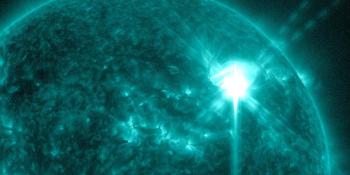Viendo archivo del viernes, 4 febrero 2005
Informe actividad solar
Any mentioned solar flare in this report has a scaling factor applied by the Space Weather Prediction Center (SWPC). Because of the SWPC scaling factor, solar flares are reported as 42% smaller than for the science quality data. The scaling factor has been removed from our archived solar flare data to reflect the true physical units.
Informe de actividad Solar-Geofísica 2005 Feb 04 2200 UTCPreparado por NOAA © SWPC y procesado por SpaceWeatherLive.com
Informe conjunto USAF/NOAA de actividad Solar y Geofísica
SDF Número 035 Publicado el 2200Z a las 04 Feb 2005IA. Análisis de regiones solares activas y de actividad desde 03-2100Z hasta 04-2100Z Solar activity was low. A single C1 flare occurred at
04/1509Z from a source on the east limb near N14. This is likely the
return of old Region 720 (N13, L=178), which produced several major
flares during its previous transit across the visible disk. Several
brightenings near the northeast limb suggest this region is still
quite active. A CME at 04/0731Z occurred in association with a
prominence eruption from the northeast limb. The CME does not appear
to be Earth directed. New Region 730 (S20E73) was numbered today and
produced occasional B-class flares.
IB. Pronóstico de la actividad solar
Solar activity is expected to be low
to moderate. The probability for M-class activty will increase
following the return of old Region 720 on 05 February.
IIA. Resumen de la actividad geofísica 03-2100Z a 04-2100Z
The geomagnetic field was quiet. Solar wind speed began the period at
over 500 km/s, but gradually decreased to near 430 km/s. The greater
than 2 MeV electron flux at geosynchronous orbit was at high levels
again today.
IIB. Pronóstico de la actividad geofísica
The geomagnetic field is
expected to be predominantly quiet with occasional unsettled periods
on 05 and 06 February. A coronal hole high speed stream is expected
to rotate into geoeffective position on 07 February and induce
occasional active periods.
III. Probabilidades del evento 05 Feb a 07 Feb
| Clase M | 15% | 25% | 25% |
| Clase X | 05% | 05% | 05% |
| Protón | 01% | 01% | 01% |
| PCAF | green | ||
IV. Penticton 10.7cm flujo
Observado 04 Feb 082 Previsto 05 Feb-07 Feb 090/100/115 Media de 90 Días 04 Feb 100
V. Índices Geomagnéticos A
Observado Afr/Ap 03 Feb 005/008 Estimado Afr/Ap 04 Feb 005/004 Previsto Afr/Ap 05 Feb-07 Feb 005/005-005/005-010/015
VI. Probabilidades de Actividad Geomagnética 05 Feb a 07 Feb
| A. Latitudes Medias | |||
|---|---|---|---|
| Activo | 10% | 10% | 25% |
| Tormenta Menor | 01% | 01% | 10% |
| Tormenta Mayor-Severa | 01% | 01% | 01% |
| B. Latitudes Altas | |||
|---|---|---|---|
| Activo | 15% | 15% | 40% |
| Tormenta Menor | 05% | 05% | 20% |
| Tormenta Mayor-Severa | 01% | 01% | 05% |
< < Ir a la visión general diaria
Últimas noticias
Últimos mensajes del foro
AR3664 79Incoming Active Regions 236Sporadic E and Flare activity 21AR3663 238Filaments and prominences 79
Más temasApoye a SpaceWeatherLive.com!
Mucha gente viene a SpaceWeatherLive para seguir la actividad del Sol o previsión de aurora, pero con esta cantidad de tráfico se incrementan los costos del servidor. ¡Considere hacer una donación si disfruta de SpaceWeatherLive para que podamos mantener el sitio web en línea!

Hechos clima espacial
| Último evento clase X | 2024/05/06 | X4.52 |
| Último evento clase M | 2024/05/07 | M8.1 |
| Últimas tormentas geomagnéticas | 2024/05/06 | Kp5 (G1) |
| Días sin manchas | |
|---|---|
| Último día sin manchas | 2022/06/08 |
| Promedio de manchas solares mensuales | |
|---|---|
| abril 2024 | 136.5 +31.6 |
| Last 30 days | 159 +66.6 |


